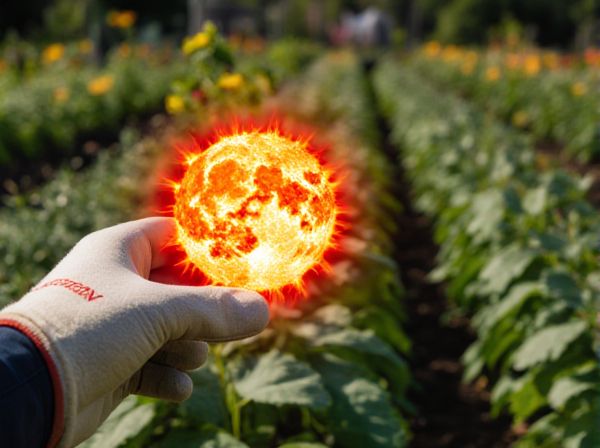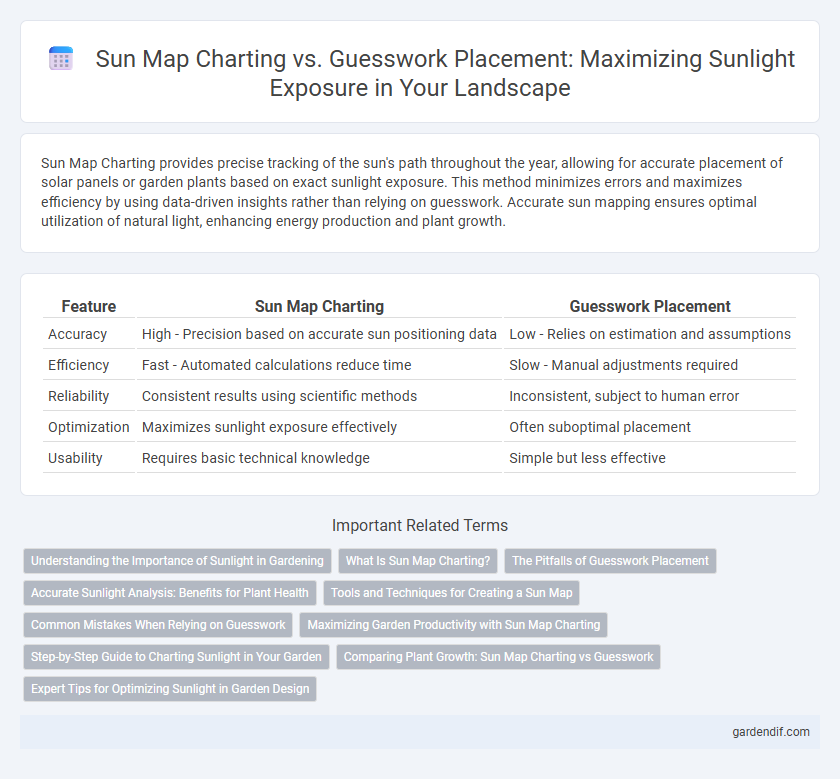
Sun Map Charting vs Guesswork Placement Illustration
Sun Map Charting provides precise tracking of the sun's path throughout the year, allowing for accurate placement of solar panels or garden plants based on exact sunlight exposure. This method minimizes errors and maximizes efficiency by using data-driven insights rather than relying on guesswork. Accurate sun mapping ensures optimal utilization of natural light, enhancing energy production and plant growth.
Table of Comparison
| Feature | Sun Map Charting | Guesswork Placement |
|---|---|---|
| Accuracy | High - Precision based on accurate sun positioning data | Low - Relies on estimation and assumptions |
| Efficiency | Fast - Automated calculations reduce time | Slow - Manual adjustments required |
| Reliability | Consistent results using scientific methods | Inconsistent, subject to human error |
| Optimization | Maximizes sunlight exposure effectively | Often suboptimal placement |
| Usability | Requires basic technical knowledge | Simple but less effective |
Understanding the Importance of Sunlight in Gardening
Accurate sun map charting enables gardeners to precisely identify sunlight patterns, optimizing plant placement for growth and health. Unlike guesswork placement, which risks partially shaded areas or excessive exposure, sun mapping ensures plants receive the ideal duration and intensity of sunlight. Understanding sunlight distribution through detailed charts improves watering schedules, nutrient application, and overall garden productivity.
What Is Sun Map Charting?
Sun Map Charting is a precise method for tracking the sun's position and movement throughout the day using detailed solar diagrams and data. This technique enables accurate planning for architecture, gardening, and solar energy projects by providing exact sunlight exposure patterns. Unlike guesswork placement, Sun Map Charting relies on scientific calculations and geographical coordinates to optimize sunlight utilization.
The Pitfalls of Guesswork Placement
Guesswork placement in sunlight charting often results in inaccurate data that misleads plant growth optimization and energy efficiency assessments. Unlike precise sun map charting, guesswork fails to account for seasonal variations and obstructions that impact sunlight exposure. This inaccuracy can lead to suboptimal positioning of solar panels and garden layouts, reducing overall effectiveness and sustainability.
Accurate Sunlight Analysis: Benefits for Plant Health
Accurate sun map charting provides precise data on sunlight exposure, enabling optimal plant placement for enhanced photosynthesis and growth. By eliminating guesswork, it helps prevent under or overexposure, reducing stress and disease risks in plants. This targeted sunlight analysis promotes healthier, more resilient plants, improving overall garden productivity.
Tools and Techniques for Creating a Sun Map
Sun map charting utilizes precise solar tracking tools and GIS software to accurately plot sun paths and shadow projections, enhancing spatial awareness and energy planning. Advanced techniques such as solar angle measurement, time-lapse photography, and 3D modeling replace guesswork placement, ensuring data-driven decisions for optimal sunlight exposure. These methods improve the design of solar installations, landscaping, and architecture by providing reliable, location-specific solar information.
Common Mistakes When Relying on Guesswork
Relying on guesswork for sunlight placement often leads to significant errors such as inaccurate shadow prediction, improper orientation of solar panels, and inefficient use of natural light, which reduces energy savings and indoor comfort. Common mistakes include neglecting seasonal sun angles, failing to account for surrounding obstacles, and overlooking geographic location-specific solar patterns. Utilizing sun map charting provides precise data-driven insights that improve decision-making accuracy and optimize sunlight exposure for both residential and commercial applications.
Maximizing Garden Productivity with Sun Map Charting
Sun map charting leverages precise tracking of solar angles and daily sunlight patterns to optimize plant placement, ensuring each species receives its ideal light exposure for photosynthesis and growth. This method reduces the risks of shadowing and underexposure that often arise from guesswork placement, leading to enhanced plant health and higher yields. By integrating sun path data, gardeners can strategically design garden layouts that maximize productivity and resource efficiency throughout the growing season.
Step-by-Step Guide to Charting Sunlight in Your Garden
Charting sunlight in your garden requires precise measurement of sun exposure at various times of the day to optimize plant placement. Using tools like a sun map or solar path chart allows for accurate tracking of shadow patterns and light intensity, eliminating guesswork in garden planning. This step-by-step approach ensures each plant receives the ideal amount of sunlight based on its specific needs, enhancing growth and productivity.
Comparing Plant Growth: Sun Map Charting vs Guesswork
Sun map charting optimizes plant growth by accurately identifying sunlight patterns throughout the day, ensuring plants receive their ideal light exposure for photosynthesis. In contrast, guesswork placement often results in inconsistent sunlight, causing uneven growth and reduced yield due to under- or overexposure. Utilizing sun map data leads to healthier plants, higher productivity, and more efficient garden layouts.
Expert Tips for Optimizing Sunlight in Garden Design
Sun map charting offers precise data on sun paths, enabling gardeners to position plants according to optimal light exposure, significantly enhancing growth and health. Expert tips emphasize using digital tools and apps to track sunlight throughout the day, avoiding guesswork that often leads to under- or overexposed plants. Incorporating sun map analysis in garden design ensures tailored plant placement, maximizing photosynthesis and overall garden productivity.
Sun Map Charting vs Guesswork Placement Infographic

 gardendif.com
gardendif.com